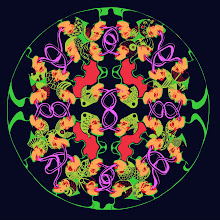Well perhaps that is not entirely true. Often it begins with me asking one of my friends to pose in somewhat ridiculous positions, “um lauren do you think you could walk around on the tips of your toes, while simultaneously bending your legs, as if you could not just walk around but more like take huge lounges and as you do it twist your torso from side to side?” This mind you is one of my less ridiculous directions... Thankfully I have generous friends who are used to a certain amount of strange requests from me and are gracious enough to act as if my request is not that strange.
But ultimately there come out of this, strange but beautiful images, full of tension and movement, and an energy that is not put on for the camera but truly there in the amount of strain the poses cause my models, even if in the image the poses seem unexpected but oddly natural. Currently my muse is Lauren Brantley, who I have to admit brought her usual cheery and easy-going attitude to set only to surprise me with intense poses that balanced the awkwardness of the pose with a confidence and embracing of it.

I took this picture this past spring as I worked on this composite- Between Heaven and Hell There is Limbo,
 (thanks again to my models, Matt Wollin, Lauren Brantley, Darran Moore, Jennifer Monge, Gabriela Hernandez, Burge Abiral, Hari Ramesh)
(thanks again to my models, Matt Wollin, Lauren Brantley, Darran Moore, Jennifer Monge, Gabriela Hernandez, Burge Abiral, Hari Ramesh)But as always there were about 100 shots of each model and I ended up only using 1 or 2 for each person which leaves many pictures that could be good enough to use for reference material, including Lauren's picture that is the starting point for the piece I have been working on for the past 3 weeks. The piece is an evolution of my recent works on paper, Residue

and a series Burst,




And as always it is an attempt to make the everyday individual larger than life, this time not only metaphorically but physically, while still capturing all the specificity and minute details that always seems to represent to me the breadth of our experience, memories, dreams and fears, limitations, and especially of our possibilities.
I've begun working on a large scale piece and after sketching and transferring the image of the body,



I was ready to really begin.
And thus came the hair. I never feel like I have started to work on a piece, I never feel fully committed to it until I start to add color and patterns to it; making the jump from a non-specific body to a body with a history and imagination that exists in a world carefully crafted by me. And the hair is where I always begin, creating an extension of the head that expands into space, full of movement and taking over the paper and creating a type of netting that seems to support the image and body, almost as if making the march through space became easier when the body is being partly lifted by this system of little objects that connect to make the hair.
Usually I like to think of my patterns as things contained within the body that start to seep through our pores, but with the hair goes beyond that. It bursts through holding each body up in its movement, could it be our dreams contained in our brain that escaped and decided to infiltrate the space taking over everything? Our brain unraveling? Each little pattern being a neuron firing out making a connection recording a momentary experience, the smell of gasoline while the car is getting filled up or the feeling of the wooden handle on your hands as you roll some cookie dough, perhaps the color of the liquid being injected in you as you are given a shot. They move around growing expanding creating an overwhelming mass exuberant and unapologetic.
The hair sets the tone for the whole piece. It reminds me to be bold in my choices. After 3 weeks of work though, I've come to realize that doing small detailed work on a large piece of paper with several layers is quite a lot of work. It takes much longer to proportionally cover the same amount of paper so that the work becomes that much slower, and my arm that much more tired. And still as I work and realize that after so many hours of work there are still so many more to come I am excited to discover and create.
The piece is far from finished but I thought I might share with you the beginnings of this piece and have you experience its conception along with me as it mutates and grows.
















































